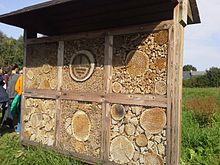This is a story about how an educator thought outside the box.
Each year, Katie Martin-Meurer, an art instructor at the University of Wisconsin, Madison, saw something that disturbed her. The students in her three-dimensional design course would simply toss their projects into the trash after they had been graded. What a waste!
Her first thought was to assign a type of project that would have some lasting value, like designing and building birdhouses for a local park. But then my favorite law — the Law of Unintended Consequences — intervened with a warning. A little research showed there would not be enough food (think insects) to support a larger bird population. Martin-Meurer learned that such vital small animals as insects and worms have declined by an average of 45 percent over the past 35 years. You can probably guess the main reasons, factors like insecticides and loss of habitat.
Her solution was to take this to the next level — help reverse this loss of habitat by building “insect hotels.”
Actually, this idea is not as radical as it sounds, although this is the first time I’ve heard of it. I googled the term and got 189,000 hits. Insect hotels can be made of natural materials and can either be designed for a specific bug or have multiple compartments. They are even for sale ready-made. So far, this project has led to about 90 insect hotels being installed in a state park in downtown Milwaukee.
Some people enjoy creating butterfly gardens; here is another option to help some very important animals.
Read about Katie Martin-Meurer and her project at http://www.npr.org/2017/05/30/530769818/college-art-professor-challenges-students-to-build-insect-motels . An explanation of insect hotels can be found at (where else?) Wikipedia — https://en.wikipedia.org/wiki/Insect_hotel . The photos came from Wikipedia.



